
Back Bloedlating Afrikaans فصد Arabic ཁྲག་གཏར་བའི་གསོ་བཅོས་ Tibetan Sagnia Catalan Pouštění žilou Czech Åreladning Danish Aderlass German Αφαίμαξη Greek Sangeltiro Esperanto Sangría (tratamiento médico) Spanish
| Bloodletting | |
|---|---|
 Bloodletting in 1860 | |
| MeSH | D001815 |

Bloodletting (or blood-letting) is the withdrawal of blood from a patient to prevent or cure illness and disease. Bloodletting, whether by a physician or by leeches, was based on an ancient system of medicine in which blood and other bodily fluids were regarded as "humours" that had to remain in proper balance to maintain health. It was the most common medical practice performed by surgeons from antiquity until the late 19th century, a span of over 2,000 years.[1] In Europe, the practice continued to be relatively common until the end of the 19th century.[2] The practice has now been abandoned by modern-style medicine for all except a few very specific medical conditions.[3] In the beginning of the 19th century, studies had begun to show the harmful effects of bloodletting.[4]
Today, the term phlebotomy refers to the drawing of blood for laboratory analysis or blood transfusion.[5] Therapeutic phlebotomy refers to the drawing of a unit of blood in specific cases like hemochromatosis, polycythemia vera, porphyria cutanea tarda, etc., to reduce the number of red blood cells.[6][7] The traditional medical practice of bloodletting is today considered to be a pseudoscience.[8]
- ^ "Bloodletting". British Science Museum. 2009. Archived from the original on 15 April 2009. Retrieved 12 July 2009.
- ^ B.) Anderson, Julie, Emm Barnes, and Enna Shackleton. "The Art of Medicine: Over 2,000 Years of Images and Imagination [Hardcover]." The Art of Medicine: Over 2,000 Years of Images and Imagination: Julie Anderson, Emm Barnes, Emma Shackleton: ISBN 978-0226749365: The Ilex Press Limited, 2013.
- ^ Mestel, Rosie (6 August 2001). "Modern Bloodletting and Leeches". Los Angeles Times. Retrieved 12 July 2009.
- ^ "Why fair tests are needed". jameslindlibrary.org. 2009. Archived from the original on 2 January 2007. Retrieved 8 January 2017.
- ^ Phlebotomy (book). Bonnie K. Davis. 2001. ISBN 978-0-7668-2518-5. Retrieved 12 July 2009.
- ^ "The Basis of Therapeutic Phlebotomy". James C. Barton, M.D. 2009. Archived from the original on 8 April 2011. Retrieved 12 July 2009.
- ^ "Therapeutic Phlebotomy". Carteret General Hospital. 2009. Archived from the original on 7 July 2009. Retrieved 12 July 2009.
- ^ Williams, William F. (2013). Encyclopedia of Pseudoscience: From Alien Abductions to Zone Therapy. Routledge. ISBN 978-1135955298.